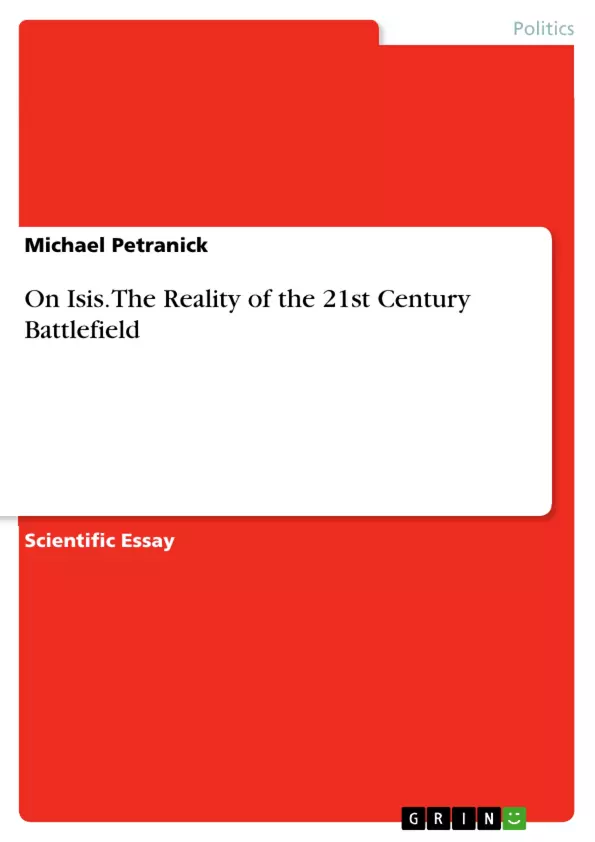This paper discusses in varying detail the realities of the twenty-first-century battlefield environment. Unless practiced by large nation-states against each other, conventional warfare is a dying platform by which asymmetric warfare and terrorism have replaced the conventional warfare dynamic. Asymmetric warfare is defined as the blurring of the lines between politics, economics, combatants, civilians, and their context in the prosecution of war on an ever changing battlefield. Inclusive in this dynamic is cyber, communications, terrorism, the use of civilians as human shields and as both offensive and defensive weapons.
Fourth generation warfare, as asymmetrical warfare has come to be known, is not new. It has existed in every war since the dawn of man. What is different is the total application of asymmetric components on a battlefield as a means to fight. The population-centric model, as espoused by the United States Army and Marine Corps, has now made it into the lexicon of air operations in Iraq, a segment of war prosecution it was never designed for. As a result, the Air Force has been subjected to mission paralysis and ultimately, mission failure.
David Galula gave future military commanders guidance, not hard and fast rules. Rules of engagement have come to favor the enemy, and if the reality of war does not return to those in command, the United States may never win another war.
Inhaltsverzeichnis (Table of Contents)
- Abstract
- ON ISIS
- Understanding the enemy
- War has always been considered a last resort
- The existence of ISIS provides a sectarian group a "home" in which Sunnis can relish newly-found power, wealth, a sense of belonging, and, the ability to change the world according to their religious beliefs.
- Iraq, the modern nation-state, was established by Western powers after the First World War where Sunnis, Shia, Kurd, Jew, Christian, and other religious groups have coexisted and intertwined for centuries before Western influence.
- History has demonstrated that demented men care little in the processes of peace and diplomacy.
- ISIS leadership follows in the vein of Hitler, seeking to subjugate land and peoples, bring disenfranchised Sunnis into the fold, establish a sovereign state, and wield absolute power from their established Caliphate.
- The Islamic State of Iraq and al-Sham, referred to in this paper as the Islamic State (IS), has changed the Westphalian theory of statecraft and war as a diplomatic tool.
- The Westphalian model came from a revolution that established the modern state and provided a definition of state sovereignty as the “supreme authority within a territory.”
- The Peace of Westphalia was signed in 1648 ending the Thirty Years War.
- Modern day national sovereignty has become a blurred ideation across the Middle East.
Zielsetzung und Themenschwerpunkte (Objectives and Key Themes)
This paper examines the realities of 21st-century warfare, focusing on the rise of asymmetric warfare and terrorism, and the challenges they pose to conventional military strategies. It explores the evolution of warfare from the traditional Westphalian model to the contemporary reality of the Islamic State (IS) and its impact on international security.
- The nature of asymmetric warfare and its implications for conventional military operations.
- The rise of the Islamic State (IS) and its influence on the contemporary battlefield.
- The limitations of traditional diplomacy and the need for a new approach to dealing with radical extremist groups.
- The failure of Western strategies in understanding and combating the motivations and goals of extremist groups.
- The significance of historical precedents and their relevance to understanding the current challenges posed by IS.
Zusammenfassung der Kapitel (Chapter Summaries)
The paper begins by defining asymmetric warfare and its characteristics, highlighting the blurring of lines between combatants and civilians, politics and economics, and the use of cyber and communications technologies. It then examines the historical context of this type of warfare, arguing that while its components have always existed, the total application of these elements on the battlefield as a means to fight is a recent phenomenon.
The paper explores the Islamic State’s (IS) ideology and its appeal to disenfranchised Sunni Muslims, arguing that the group’s success is not solely attributable to social and economic factors but also to its effective utilization of power and its ability to offer a sense of belonging and purpose. It examines the historical and contemporary contexts of the Sunni-Shia conflict, emphasizing the role of power struggles and the erosion of traditional diplomacy in fostering extremism.
The paper delves into the historical evolution of the Westphalian model of state sovereignty, examining its origins and its relevance to the contemporary world. It highlights the blurring of traditional notions of sovereignty in the Middle East, particularly in the context of IS, and the challenges this presents to international security and stability.
Schlüsselwörter (Keywords)
Asymmetric warfare, terrorism, Islamic State (IS), Westphalian model, diplomacy, power, sectarianism, Sunni-Shia conflict, state sovereignty, international security.
- Quote paper
- Michael Petranick (Author), 2015, On Isis. The Reality of the 21st Century Battlefield, Munich, GRIN Verlag, https://www.grin.com/document/311551



